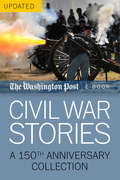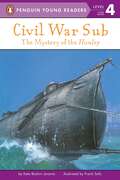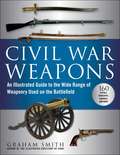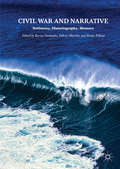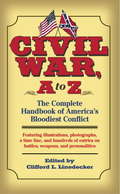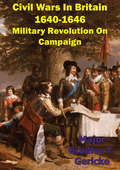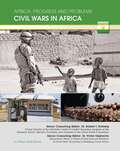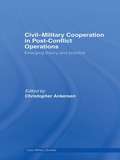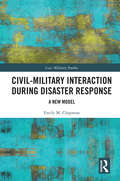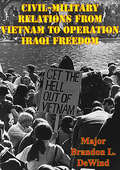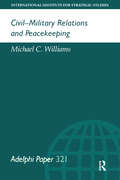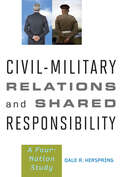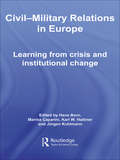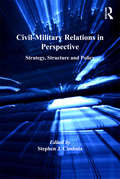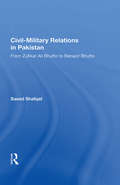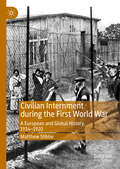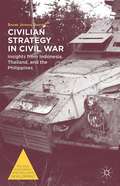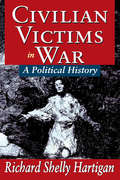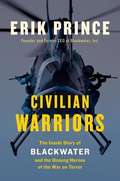- Table View
- List View
Civil War Stories: A 150th Anniversary Collection
by The Washington PostThis fascinating compendium examines the legacy of the War Between the States. At the Washington Post, the Civil War has held an enduring fascination for both readers and writers. Raging from 1861 to 1865, the War Between the States has left a lasting imprint on the United States’s collective psyche for 150 years. Civil War Stories: A 150th Anniversary Collection aggregates historical data with contemporary reflections, as journalists and historians put the bloody war into context: A timeline of Lincoln’s candidacy—and what may have happened if he had lost the electionAn ode to West Virginia, which abandoned Virginia rather than secede from the UnionThe obstacles faced by emancipated slavesWomen in the federal workforce—and disguised as men on the battlefieldsThe modern anti-slavery crusade of Frederick Douglass’s great-great-great-grandson Personal stories of tragedy and triumph still resonate today. From biographical histories to examinations of the war’s legacies, Civil War Stories: A 150th Anniversary Collection is a unique compilation of stories of when our nation was divided.
Civil War Sub: The Mystery of the Hunley (Penguin Young Readers, Level 4)
by Kate Boehm JeromeIn 1864, during the Civil War, the C.S.S. Hunley became the first submarine in the world to sink an enemy ship. The Hunley and its crew mysteriously vanished. What happened on that cold winter night? After over a century, scientists finally have some of the answers.
Civil War Supply and Strategy: Feeding Men and Moving Armies
by Earl J. HessWinner of the Colonel Richard W. Ulbrich Memorial Book AwardWinner of the Army Historical Foundation Distinguished Writing AwardCivil War Supply and Strategy stands as a sweeping examination of the decisive link between the distribution of provisions to soldiers and the strategic movement of armies during the Civil War. Award-winning historian Earl J. Hess reveals how that dynamic served as the key to success, especially for the Union army as it undertook bold offensives striking far behind Confederate lines. How generals and their subordinates organized military resources to provide food for both men and animals under their command, he argues, proved essential to Union victory.The Union army developed a powerful logistical capability that enabled it to penetrate deep into Confederate territory and exert control over select regions of the South. Logistics and supply empowered Union offensive strategy but limited it as well; heavily dependent on supply lines, road systems, preexisting railroad lines, and natural waterways, Union strategy worked far better in the more developed Upper South. Union commanders encountered unique problems in the Deep South, where needed infrastructure was more scarce. While the Mississippi River allowed Northern armies to access the region along a narrow corridor and capture key cities and towns along its banks, the dearth of rail lines nearly stymied William T. Sherman’s advance to Atlanta. In other parts of the Deep South, the Union army relied on massive strategic raids to destroy resources and propel its military might into the heart of the Confederacy. As Hess’s study shows, from the perspective of maintaining food supply and moving armies, there existed two main theaters of operation, north and south, that proved just as important as the three conventional eastern, western, and Trans-Mississippi theaters. Indeed, the conflict in the Upper South proved so different from that in the Deep South that the ability of Federal officials to negotiate the logistical complications associated with army mobility played a crucial role in determining the outcome of the war.
Civil War Virginia: Battleground for a Nation
by James I. RobertsonSince Richmond was the capital of the Confederacy, it was the target for Union assaults throughout the Civil War. Virginia was the site of more than half the battles of the war, and saw extraordinary damage to civilian property. This book recounts the war as it was fought on Virginia soil, with portraits of key players and descriptions of life on the homefront as well as the battlefield.
Civil War Weapons: An Illustrated Guide to the Wide Range of Weaponry Used on the Battlefield
by Graham SmithLearn about the evolution of weapons by studying the design of the Civil War weapons cataloged in this attractive, full-color reference book. More than three million Americans fought in the Civil War and over six hundred thousand men, or two percent of the population, died in this dreadful conflict. Its impact is still felt today, for the war shaped our nation, and our national character. Studying the weapons used by both the Union army and Confederate forces tells an intriguing story of its own.The well-equipped Union army had access to the best of the industrial North's manufacturing output. By contrast, the South had to get by with imported arms and locally made copies of patented weapons. But the pressure of war quickly led to improvements in both sides' firearms. A War that began with single-shot horse pistols ended with multi-shot revolvers.Poignant archive photography is used throughout the book, showing the weapons in contemporary action, and placing them in their Civil War context. Evocative paintings by renowned Civil War artist Don Troiani bring the battlefield action to life.
Civil War along Tennessee's Cumberland Plateau, The (Civil War Series)
by Aaron AstorTennessee's Cumberland Plateau played host to some of the most dramatic military maneuvering of the Civil War. Straddling the entire state of Tennessee, the formidable tableland proved to be a maze of topographical pitfalls and a morass of divided loyalties. As Federal forces sought to capitalize on the capture of Nashville, they moved into a region split by the most vicious guerrilla warfare outside Missouri, including the colorful and intensely violent rivalry between Confederate Champ Ferguson and Unionist "Tinker" Dave Beaty. The bitter conflict affected thousands of ordinary men and women struggling to survive in the face of a remorseless war of attrition, and its legacy continues to be felt today.
Civil War and Narrative: Testimony, Historiography, Memory
by Karine Deslandes Fabrice Mourlon Bruno TriboutThis book explores the representation of intra-state conflicts. It offers a distinctive approach by looking at narrative forms and strategies associated with civil war testimony, historiography and memory. The volume seeks to reflect current research in civil war in a number of disciplines and covers a range of geographical areas, from the advent of modern forms of testimonies, history writing and public remembering in the early modern period, to the present day. In focusing on narrative, broadly defined, the contributors not only explore civil war testimonies, historiography and memory as separate fields of inquiry, but also highlight the interplay between these areas, which are shown to share porous boundaries. Chapters look at the ways in which various narrative forms feed off each other, be they oral, written or visual narratives, personal or collective accounts, or testimonies from victims or perpetrators.
Civil War, A to Z: The Complete Handbook of America's Bloodiest Conflict
by Clifford L. LinedeckerWith hundreds of entries, as well as photographs, drawings, and a handy time line of events--The Civil War A to Z encompasses everything about that historic conflict ... from Appomattox to Zouaves. Who or what are "Zouaves," you may ask? They were members of certain volunteer regiments from both the North and the South. That's just one example of the scope and depth of The Civil War A to Z. This encyclopedic, illustrated reference of the war between the States features facts both familiar and engagingly new in an easy-to-follow alphabetical format, this handy reference belongs in every Civil War library. Near an informative entry on "Robert E. Lee," you'll find startling revelations about "Lincoln's In-laws"--four of whom actually fought for the Confederacy. Not far from the battle of "Shiloh" are "Sutlers," profiteers who trailed along with armies, hawking all kinds of (sometimes shoddy) stuff. And right around "weapons" sits "General Stand Watie," the only American Indian to achieve the rank of general with the Confederacy. In short, this wonderful one-volume account ranges from the basic to the bizarre, from secession to spies to all kinds of swords, creating a complete picture of the war from the first shot to final surrender. No Civil War enthusiast or simple student of history will want to be without this indispensable and entertaining guide to one of America's most pivotal, endlessly fascinating events.
Civil Wars
by David Armitage"A highly original history, tracing civil war, the least understood and most intractable form of organized human aggression, from Ancient Rome through the centuries to present day"--
Civil Wars
by Rosellen BrownAn idealistic couple, Teddy and Jessie Carlls, former activists in the civil rights movement in the 1960s and deeply committed to racial tolerance and equality, live with their children as virtually the only whites in a black development. When Teddy's racist sister and her husband are killed in an automobile accident, the Carlls are named as guardians of their two children--budding racists in their own right--and the expanded family finds it necessary to move. Teddy and Jessie reluctantly move to a larger house in a white, middle-class neighborhood. The novel focuses on Jessie's desperate efforts to help her in-laws' children adjust both to their loss and to the atmosphere of racial tolerance the children must confront in their new family.
Civil Wars In Britain, 1640-1646: Military Revolution On Campaign
by Major Bradley T. GerickeThe military organization of nation states and their employment of armies are central aspects of early modern European history. The seventeenth century was particularly a period of transformation that witnessed drastic change in armies' preparation for and execution of military campaigns. To date, historians have tended to overlook military development as it occurred in the British Isles. Yet Britain offers the historian an interesting subject for the examination of first, how emerging ideas of military organization, doctrine, and strategy were transmitted from the European continent; and second, how British soldiers demonstrated their familiarity with contemporary military practice through the conduct of campaigns.The evidence of military publications within Britain, as well as the experience of British soldiers overseas, indicates that English and Scottish soldiers grappled with the important tenets of the continental military revolution. The campaign strategies employed by British military commanders during the Second Bishops' War of 1640 and the English Civil War of 1642-1646 were undoubtedly complex and reflective of the confused political conditions of the period. Nonetheless, British soldiers attempted to fight and to win using a contemporary, thoroughly European understanding of warfare.
Civil Wars in Africa (Africa: Progress and Problems)
by William Mark HabeebSince 1960, many African countries have been devastated by civil wars. Today, it is estimated that around 20 percent of Africas more than 1 billion people are affected, either directly or indirectly, by ongoing conflict. The widespread unrest has been a major reason the people of Africa have been unable to fully reach their potential. This book analyzes past and current conditions in Africa to shed light on the historical, cultural, governmental, religious, ethnic, and ideological factors that have caused civil wars to occur. Conflicts like the long-running war in Sudan, the unrest in Liberia and Sierra Leone, and the state failure in Somalia and the Democratic Republic of the Congo are explained. The final chapter discusses ways future civil wars might be avoided.
Civil Wars, Insecurity, and Intervention
by Jack Snyder Barbara F. WalterSince the end of the cold war, a series of costly civil wars, many of them ethnic conflicts, have dominated the international security agenda. The international community, often acting through the United Nations or regional organizations like NATO, has felt compelled to intervene with military forces in many of these conflicts -- four of which comprise the heart of this book: Bosnia and Herzegovina, Somalia, Cambodia, and Rwanda. Civil Wars, Insecurity, and Interventionis a detailed examination by a host of distinguished scholars of these recent interventions in order to draw lessons for today's policy debates. The contributors view ethnic conflict and internal war through the prism of the concept of the security dilemma -- a situation in which parties with strong incentives to cooperate wind up nonetheless in bloody competition out of distrust of the opponent. Civil Wars, Insecurity, and Interventionassesses how international intervention can help solve the security dilemma in civil wars by designing political and military arrangements that make security commitments credible to the warring parties. The mixed record of partial successes, failures, and in some cases counterproductive interventions suggests an urgent need to extract lessons with a view toward developing a framework for making future policy choices.
Civil-Military Cooperation in Post-Conflict Operations: Emerging Theory and Practice (Cass Military Studies)
by Christopher AnkersenCivil-Military Cooperation (CIMIC) is the relationship between militaries and humanitarians. Largely conducted in post-conflict environments, CIMIC has become a key characteristic of military operations in the twenty-first century. However, the field is mostly understood through stereotype rather than clear, comprehensive analysis. The range and sc
Civil-Military Interaction during Disaster Response: A New Model (Cass Military Studies)
by Emily M. ChapmanThis book presents a model to help enhance civil-military interaction in disaster response settings for the benefit of affected communities and the host nation.Militaries are increasingly deploying to assist, or are present, in areas impacted by natural hazards. Drawing on the author’s own operational experience and recent case studies of natural hazard responses, the book contributes a practical and accessible approach to civil-military interaction that enables actors to negotiate a relationship where there is shared purpose. It establishes a theoretical foundation for civil-military interaction, which is then used to describe effective interaction as a process of coordination that consists of sequential and necessary conditions that contribute to humanitarian outcomes and operational effectiveness. The book is novel because it includes the voices of affected communities and it syntheses factors that influence civil-military interaction across case studies to argue that, where context allows, civilian and military actors should focus on building a purposeful relationship that places affected communities and local leadership at the forefront of responses. Using this book, practitioners will be supported to establish relationships that contribute to their respective purposes, taking into consideration the consequences of their actions on others.This book will be of much interest to students of civil-military relations, civil-military coordination, disaster responses, and International Relations in general.
Civil-Military Relations From Vietnam To Operation Iraqi Freedom
by Major Brandon L. DeWindThe end of the Cold War did not bring about the grand peace that was hoped for during four decades. Instead, the world has become more dangerous, with multiple complex problems. Military institutions worldwide must learn to adapt to the ever-changing face of the threat to fight the Global War on Terror. Services can no longer look within their own ranks to accomplish the mission; all operations must be joint in order to succeed in the contemporary operating environment.This monograph traces the thread between civil-military relations during two times of war for the U.S. The military must know what the civilian leadership requires and must, in return, articulate a clear path to achieve it, if feasible. The U.S. military never lost a battle in Vietnam and yet that conflict is looked upon as an American defeat. The war in Iraq began to look like a repeat performance. The military was clearly winning engagements on the battlefield but the talk at home, in the media, was of a "quagmire" and "stagnation" (two terms used to describe Vietnam) and ultimately, of defeat.Although this monograph uses two snapshots in time of civil-military relations, the significance of its findings apply, in general, to all students interested in civil-military relations, as well as decision making. Whether looking at times of war or peace, civil-military relations play a significant role in all matters pertaining to the running of our military; the decisions made by our civilian leadership can influence even the smallest facets of military life.
Civil-Military Relations and Peacekeeping (ISSN)
by Michael WilliamsPeacekeeping in the late 1990s is a complex and diverse task, in which civilian and military personnel are working together to a greater degree than ever before. However, when an international body such as the UN takes strategic decisions, it does so with inadequate input from the military; in the field, there are clashes of culture, confusion over command and control arrangements and insufficient operational coordination. These issues also affect regional organisations such as NATO. The awkward management of operations and their uneven level of achievement have contributed to a decline in the number of UN peacekeeping operations since 1994. This paper argues that the balance between civilian and military expertise and advice at all levels of a peacekeeping mission – strategic, tactical and operational – needs to be reappraised.At the strategic level:* mandates must be clear, and must respond both to the needs of the situation and to the resources available* there must be regular dialogue between all the principal players, military and civilian; the military-staff capacity at UN headquarters should be made more effective, and should be responsible to the Security Council* major troop-contributing countries should be systematically involved in determining mandates, as well as in reviewing operational plans* senior military officers from all large troop-contributing countries should be based at a mission’s field headquarters. At the operational level: * the office of the Special Representative of the Secretary-General – the head of a UN peacekeeping mission – should be strengthened. In non-UN operations, the authority of the High Representative needs to be increased* a cadre of civilian officials with peacekeeping experience needs to be developed; standard operating procedures for the civilian head of a mission to follow when dealing with the military need to be developed* greater emphasis should be placed on the ‘softer’ aspects of military science – managing resources, civilian control and human rights* the reluctance of civilians and non-governmental organisations to engage with the military should be addressed.Much experience has been gained from the peacekeeping operations of the 1990s, but both military and civilian participants must make considerably more progress before they can be said to have forged a partnership that makes them an effective intervention force
Civil-Military Relations and Shared Responsibility: A Four-Nation Study
by Dale R. HerspringA provocative approach to evaluating civil-military relations.Dale R. Herspring considers the factors that allow some civilian and military organizations to operate more productively in a political context than others, bringing into comparative study for the first time the military organizations of the U.S., Russia, Germany, and Canada. Refuting the work of scholars such as Samuel P. Huntington and Michael C. Desch, Civil-Military Relations and Shared Responsibility approaches civil-military relations from a new angle, military culture, arguing that the optimal form of civil-military relations is one of shared responsibility between the two groups. Herspring outlines eight factors that contribute to conditions that promote and support shared responsibility among civilian officials and the military, including such prerequisites as civilian leaders not interfering in the military's promotion process and civilian respect for military symbols and traditions. He uses these indicators in his comparative treatment of the U.S., Russian, German, and Canadian militaries. Civilian authorities are always in charge and the decision on how to treat the military is a civilian decision. However, Herspring argues, failure by civilians to respect military culture will antagonize senior military officials, who will feel less free to express their views, thus depriving senior civilian officials, most of whom have no military experience, of the expert advice of those most capable of assessing the far-reaching forms of violence. This issue of civilian respect for military culture and operations plays out in Herspring's country case studies.Scholars of civil-military relations will find much to debate in Herspring's framework, while students of civil-military and defense policy will appreciate Herspring's brief historical tour of each countries' post–World War II political and policy landscapes.
Civil-Military Relations in Europe: Learning from Crisis and Institutional Change (Cass Military Studies)
by Hans BornThis new book illustrates how democracy cannot develop or endure unless military and security forces are under the full control of democratic institutions and all the necessary safeguards, checks and balances are in place. The contributors show how contemporary European states manage the following issue: how does a society, primarily through its legitimate, democratically elected political leaders and their appointed officials, control the military, that same state institution that has been established for its protection and wields the monopoly of legitimate force? Twenty-eight case studies are selected from key countries: the Czech Republic, Germany, Georgia, France, Hungary, Ireland, Israel, Macedonia, Poland, Romania, Slovenia, Serbia and Montenegro, Switzerland and the Ukraine. The key subjects of these cases vary from corruption to military incompetence, disobedience towards civilian superiors, to unauthorized strikes and accidents. The focus is on the relationship between political, civilian and military actors while identifying problems and dangers that can emerge in those relations to the detriment of effective and legitimate democratic control. This is essential reading for students of civil-military relations, democratization, European politics and security studies in general.
Civil-Military Relations in Perspective: Strategy, Structure and Policy
by Stephen J. CimbalaThe topic of civil-military relations has high significance for academics, for policy makers, for military commanders, and for serious students of public policy in democratic and other societies. The post-Cold War and post-9-11 worlds have thrown up traditional as well as new challenges to the effective management of armed forces and defense establishments. Further, the present century has seen a rising arc in the use of armed violence on the part of non-state actors, including terrorists, to considerable political effect. Civil-military relations in the United States, and their implications for US and allied security policies, is the focus of most discussions in this volume, but other contributions emphasize the comparative and cross-national dimensions of the relationship between the use or threat of force and public policy. Authors contributing to this study examine a wide range of issues, including: the contrast between theory and practice in civil-military relations; the role perceptions of military professionals across generations; the character of civil-military relations in authoritarian or other democratically-challenged political systems; the usefulness of business models in military management; the attributes of civil-military relations during unconventional conflicts; the experience of the all-volunteer force and its meaning for US civil-military relations; and other topics. Contributors include civilian academic and policy analysts as well as military officers with considerable academic expertise and experience with the subject matter at hand.
Civil-military Relations In Pakistan: From Zufikar Ali Bhutto To Benazir Bhutto
by Saeed ShafqatTaking an explicitly comparative theoretical approach, Saeed Shafqat presents a comprehensive exploration of civil-military relations in Pakistan. He begins by describing the history of military hegemony in this volatile South Asian country and then examines the breakdown of military control, assessing the rise of the Pakistan People's Party and th
Civilian Internment during the First World War: A European and Global History, 1914—1920
by Matthew StibbeThis book is the first major study of civilian internment during the First World War as both a European and global phenomenon. Based on research spanning twenty-eight archives in seven countries, this study explores the connections and continuities, as well as ruptures, between different internment systems at the local, national, regional and imperial levels. Arguing that the years 1914-20 mark the essential turning point in the transnational and international history of the detention camp, this book demonstrates that wartime civilian captivity was inextricably bound up with questions of power, world order and inequalities based on class, race and gender. It also contends that engagement with internees led to new forms of international activism and generated new types of transnational knowledge in the spheres of medicine, law, citizenship and neutrality. Finally, an epilogue explains how and why First World War internment is crucial to understanding the world we live in today.
Civilian Strategy in Civil War
by Shane Joshua BarterWhile typically the victims of war, civilians are not necessarily passive recipients of violence. What options are available to civilians in times of war? This book suggests three broad strategies - flight, support, and voice. It focuses on three conflicts: Aceh, Indonesia; Patani, southern Thailand; and Mindanao, southern Philippines.
Civilian Victims in War: A Political History
by Hugh DaunceyThe status of the civilian today is that of a calculated casualty, to die immediately or after agonizing suffering. The civilian is also a hostage in the political power struggle, since his continued safety depends upon the decision or even impulse of his leaders. This is true if he is a citizen of a major power, or if he lives elsewhere in unstable social and political environments. Hartigan's book is a unique effort to deal with a mass, but hidden problem: the status of the civilian non-combatant in conditions of armed conflict.Civilian Victims in War fills the gaps in our knowledge of the origins of civilian immunity, so that a full evaluation of the principle's continued worth may be made. The book reviews the concepts of noncombatants, civilian immunity, how it arose from need and intuition and developed into legal practice. The volume focuses on the development of this concept in the Western tradition, not because civilian immunity was absent in Asia or Africa, but because its present formulation owes its origin and elaboration to European custom, practice, and thought.Civilian Victims in War is the first book to deal with the central theme of the innocent non-combatant. Hartigan seeks to pursue this subject in greater depth, and asks the intelligent layman to reconsider his or her options in the face of modern warfare. He touches on many subjects in this work which will spark interest with the general public and policy personnel, those who should recognize themselves as civilians and see this book as their tragic history.
Civilian Warriors: The Inside Story of Blackwater and the Unsung Heroes of the War on Terror
by Erik PrinceForget everything you think you know about Blackwater. And get ready for a thrilling, true story that will make you rethink who the good guys and bad guys have been since 9/11. No company in our time has been as mysterious or as controversial as Blackwater. Founded by former Navy SEAL Erik Prince in 1997, it recruited special forces veterans and others with the skills and courage to take on the riskiest security jobs in the world. As its reputation grew, government demand for its services escalated, and Blackwater's men eventually completed nearly one hundred thousand missions in Iraq and Afghanistan. Both the Bush and Obama administrations found the company indispensible. It sounds like a classic startup success story, except for one problem: Blackwater has been demonized around the world. From uninformed news coverage to grossly distorted fictional portrayals, Blackwater employees have been smeared as mercenaries, profiteers, jackbooted thugs, and worse. Because of the secrecy requirements of Blackwater's contracts with the Pentagon, the State Department, and the CIA, Prince was unable to speak out when his company's opponents spread false information. But now he's able to tell the full and often shocking story of Blackwater's rise and fall. In Civilian Warriors, Prince pulls no punches and spares no details. He explains his original goal of building an elite center for military and law enforcement training. He recounts how the company shifted gears after 9/11. He honors our troops while challenging the Pentagon's top leadership. And he reveals why highly efficient private military contractors have been essential to running our armed forces, since long before Blackwater came along. Above all, Prince debunks myths about Blackwater that spread while he was forced to remain silent--myths that tarnished the memory of men who gave their lives for their country but never got the recognition they deserved. He reveals new information about some of the biggest controversies of the War on Terror, including: * The true story of the Nisour Square massacre in Baghdad. * The actual details of Blackwater's so-called impunity in Iraq. * The events leading up to the televised deaths of Blackwater contractors in Fallujah. Prince doesn't pretend to be perfect, and he doesn't hide the sometimes painful details of his private life. But he has done a great public service by setting the record straight. His book reads like a thriller but is too improbable to be fiction.
